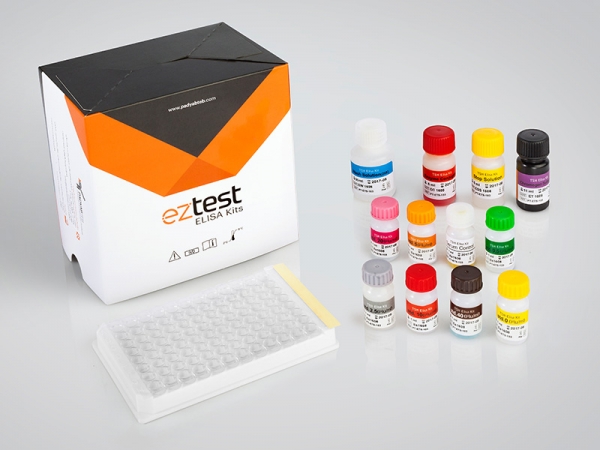| Name | T4 ELISATest |
| Full name | Human T4 ELISA Test Kit |
| Category Name | Thyroid ELISA kits |
| Test | 96 |
| Method | ELISA method: Enzyme Linked Immunosorbent Assay |
| Principle | Competitive ELISA |
| Detection Range | 0-30 µg/dl |
| Sample | 25µL |
| Sensitivity | 1 µg/dl |
| Total Time | ~60 min |
| Shelf Life | 12 Months from the manufacturing date |
T4 ELISA kit description:
The T4 ELISA is intended for the quantitative determination of the Thyroxine (T4) concentration in human serum.
Materials provided with T4 ELISA Test Kit:
1. Anti-T4 Antibody-coated ELISA Microplate (96 wells)
2. T4 enzyme conjugate reagent: 1 Vials contains anti-T4-HRP with preservative buffer, ready to use.(1 Vials, 12 ml)
3. T4 standard set, contains 0, 2.5, 5, 10, 15, 30 µg/dl , ready for use. (6 vials. 1 ml)
4. TMB Substrate: Hydrogen peroxide and tetra-methyl benzidine in preservative buffer, ready to use. (1 vial of 11ml)
5. Stop Solution: a normal hydrochloric acid (1 vial, 6 ml).
6. Concentrated washing buffer: PBS-Tween (1 vial 30ml) (20X)
7. Control serum: T4 in serum with preservatives(1Vial, 1 ml)
Materials Required, not Provided:
1. Precision pipettes(20,50,100, µl)
2. Distilled or deionized water
3. EIA kit Microplate Washer
4. EIA kit Microplate Reader with a 450 nm, If possible, 630 nm as reference.
5. Absorbent paper
Introduction
Thyroxine (T4) or 3,5,3’,5’-tetraiodothyronine is the main thyroid gland hormone that is regulated by the hypothalamus and pituitary sensitive feedback mechanism. Secreted TRH by hypothalamus stimulates the pituitary to release TSH, which causes the release of T4 and T3 by affecting the thyroid. T3 and t4 hormones control the secretion of TSH and TRH by feedback mechanism. More than 99% of T4 is reversibly bound to three plasma proteins in blood - thyroxine binding globulin (TBG) binds 70%, thyroxine binding pre-albumin (TBPA) binds 20%, and albumin binds 10%; so, less than 0.1% of T4 is in the free, unbound state in blood at any time. This free T4 is able to enter to the cells and apply its biological effect by binding to TBG. Measurement of total T4 by immunoassay is the most reliable screening test for determination of the presence of thyroid disorders in patients. Increased levels of T4 have been found in hyper-thyroidism due to Grave’s disease and Plummer’s disease and in acute and subacute thyroiditis. Low levels of T4 have been associated with congenital hypothyroidism, myxedema, chronic thryoiditis (Hashimoto’s disease), and with some genetic abnormalities.
Principle of the assay
This ELIZA assay utilizes a highly specific T4 monoclonal antibody that a certain amount of anti-T4 antibody is coated on the wells. A measured amount of patient serum, and a constant amount of T4 conjugated with HRP are added to the microtiter wells. In this assay, 8-anilino-1-napthalene sulfonate (ANS) is used to displace T4 from proteins to enable the measurement of total circulating T4. During the incubation period, T4 and conjugated T4 compete for the limited binding sites on the anti-T4 antibody. After 45 minutes incubation at room temperature, the wells are washed by washing Solution. Then substrate solution and chromogen solution are added and incubated for 15 minutes, resulting in the development of blue color. The color development is stopped with the addition of stop solution, and the color is changed to yellow and absorbance is measured spectrophotometrically at 450 nm. The color intensity is inversely related to the concentration of T4 in the test sample.



